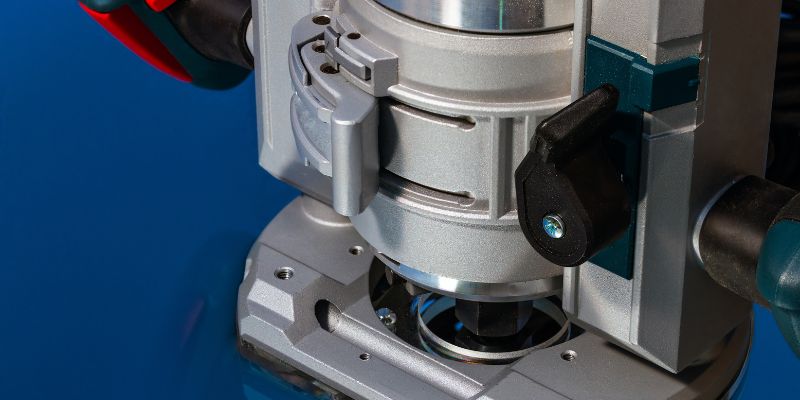The main difference between a trim router and a plunge router lies in their functionality and versatility. The trim router is primarily used for trimming and shaping edges, while the plunge router allows for controlled plunge cuts and precise depth adjustments.
Depending on your woodworking needs, selecting the right router will determine the outcome of your project. When working on woodworking projects, having the right tools can make all the difference. Two popular options to consider are trim routers and plunge routers.
Understanding the key differences between these two types of routers can guide you in making an informed decision for your project. We will explore the distinctions between trim routers and plunge routers, including their unique features and applications. Whether you are a professional woodworker or a DIY enthusiast, having a clear understanding of these tools will help you choose the most suitable one for your needs. So let’s dive in and explore the differences between trim routers and plunge routers.
Features And Differences
When it comes to woodworking and other intricate tasks, choosing the right power tool can make a world of difference. Two popular options in the market are the trim router and plunge router. While both tools excel at making accurate cuts and precise designs, they have distinct features and differences. Let’s take a closer look at each tool and explore their variations.
Size And Weight
One of the key factors to consider when selecting a router is its size and weight. In this regard, the trim router takes the crown. These compact powerhouses are designed to be lightweight and easy to maneuver, making them ideal for delicate and detailed work. They are smaller in size, which allows for enhanced control and precision. On the other hand, plunge routers are bulkier and slightly heavier due to the added mechanisms required for plunge action. While they may not be as nimble as trim routers, plunge routers are built for versatility and can handle larger projects with ease.

Base Type And Functionality
The base type and functionality of each router also sets them apart. Trim routers typically come with a fixed base, which offers stability and ensures consistent cutting depths. The fixed base also enables easy adjustment and locks securely in place, boosting accuracy. In contrast, plunge routers are renowned for their versatility. Equipped with a spring-loaded base, these routers are capable of plunging the router bit into the workpiece at varying depths, allowing for precise and controlled cutting. The plunge feature is particularly handy when creating grooves, dados, or making cuts in the middle of a workpiece.
Depth Adjustment Mechanisms
Another crucial factor to consider when comparing trim routers and plunge routers is their depth adjustment mechanisms. Trim routers often incorporate a simple depth adjustment system, typically controlled by a knob or lever. This feature provides quick and straightforward depth adjustments, making it convenient for tasks such as trimming edges or adding decorative details. Conversely, plunge routers have a more advanced depth adjustment mechanism. These routers usually come with a turret system that allows for precise micro-adjustments by setting the depth stop at specific intervals. The depth adjustment features of plunge routers make them suitable for tasks that require absolute precision, like inlay work or carving intricate designs.
To summarize, the trim router and plunge router offer unique features and benefits, each tailored for different woodworking needs. The trim router’s compact size, lightweight design, and fixed base make it ideal for intricate, small-scale projects. Plunge routers, with their versatility, plunge action, and adjustable depth mechanisms, are better suited for larger-scale projects requiring precise cuts and depth adjustments. Ultimately, the choice between the two will depend on the specific requirements of the task at hand.
Applications And Use Cases
When it comes to woodworking and crafting, having the right tools for the job is essential. In the world of woodworking, two popular tools often used are the trim router and the plunge router. These tools are designed to perform different tasks, making them suitable for various applications and use cases. In this section, we will explore the specific applications where each router shines, helping you make an informed decision based on your project’s requirements.
Trim Router Applications
The trim router, also known as a laminate trimmer, is a compact and lightweight power tool with a fixed base. Its small size and maneuverability make it ideal for precision work and delicate details. Here are some popular applications where the trim router excels:
- Edge Trimming: The trim router is exceptional at trimming and shaping the edges of wooden boards, countertops, and other materials. Its compact design allows you to maintain control and achieve clean, smooth edges.
- Pattern Routing: Whether you need to create intricate patterns or duplicate existing shapes, the trim router is your go-to tool. It offers precision and control, allowing you to follow templates and produce consistent results.
- Flush Trimming: When you need to trim one material to be flush with another, the trim router comes in handy. It excels at removing excess material to ensure a seamless and professional finish.
- Roundovers and Chamfers: Adding decorative edges to your woodworking projects is effortless with a trim router. It can create beautiful roundovers and chamfers, enhancing the overall aesthetic of your work.
Plunge Router Applications
The plunge router, as the name implies, allows the bit to be plunged vertically into the material. This capability makes it a versatile tool for a wide range of applications. Here are some common use cases where the plunge router excels:
- Deep Routing: The plunge router is perfect for tasks that require cutting deep grooves, mortises, or dadoes. Its ability to control the depth of the cut makes it ideal for various joinery techniques.
- Routing in the Middle: Unlike the trim router, the plunge router allows you to start routing anywhere in the material, not just the edges. This feature makes it convenient for creating slots, channels, and complex designs in the middle of the workpiece.
- Template Routing: When you need to create multiple identical shapes or duplicate complex curves, the plunge router shines. It is excellent for following templates and producing consistent results.
- Engraving and Inlaying: With its plunging capability and precise depth control, the plunge router is a valuable tool for intricate engraving and inlay work. It allows you to achieve fine details and artistic designs.
Case Study: Which Router To Use For Specific Projects
Now that we’ve explored the applications and strengths of both the trim router and the plunge router, let’s take a look at a case study to determine which router is more suitable for specific projects:
| Project Type | Trim Router | Plunge Router |
|---|---|---|
| Edge Trimming and Chamfering | ✓ | |
| Creating Mortises and Dadoes | ✓ | |
| Engraving and Inlay Work | ✓ | |
| Pattern Routing | ✓ | |
| Flush Trimming | ✓ | |
| Routing in the Middle | ✓ |
Based on the case study above, it is clear that the choice between a trim router and a plunge router depends on the specific project requirements. If you need to focus on fine detailing, edge trimming, pattern routing, and flush trimming, the trim router is the tool for you. On the other hand, if your projects involve routing in the middle, creating mortises and dadoes, engraving, and inlay work, the plunge router is the better option.

Frequently Asked Questions On Trim Router Vs Plunge
What Is The Difference Between A Trim Router And A Plunge Router?
A trim router is smaller and lighter, making it ideal for precision work and trimming edges. On the other hand, a plunge router is designed for deeper cuts and allows you to make plunge cuts into the material. They both have their own unique features and applications.
Can I Use A Trim Router For Plunge Cuts?
No, a trim router is not designed for plunge cuts. It lacks the depth adjustment feature necessary for making plunge cuts into the material. If you need to make plunge cuts, it is recommended to use a plunge router instead.
What Are The Advantages Of Using A Trim Router?
Using a trim router offers several advantages, such as its compact size which allows for better control and maneuverability. It is also easier to handle, making it great for precision work and trimming edges. Additionally, it is generally more affordable compared to plunge routers.
When Should I Use A Plunge Router Instead Of A Trim Router?
A plunge router is recommended when you need to make deeper cuts, such as inlay work or mortises. It allows you to make plunge cuts into the material, which a trim router cannot do. If you require a greater depth of cut or need the ability to make plunge cuts, a plunge router is the preferable choice.
Conclusion
Ultimately, the choice between a trim router and a plunge router depends on your specific woodworking needs and preferences. Both tools offer distinct advantages and functionalities. The trim router excels at precision and fine detail work, while the plunge router provides versatility and depth control.
Consider the project requirements and your skill level to make an informed decision. Happy woodworking!


